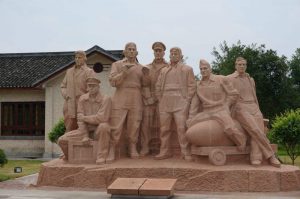
Flying Tigers Memorial Hall Museum in Kunming

Chinese Name: 飞虎队纪念馆
Chinese Pinyin: Fei Hu Ji Nian Guan
English Name: Flying Tigers Museum
Type: Museum, Historical & Cultural Landmarks
Admission Fee: Free
Opening Hours:09:30-14:30
Reccommended Visiting Time: Half an hour
Location: Located at No. 71, Tuodong Road of Kunming
Kunming Flying Tigers Memorial Hall (昆明飞虎队纪念馆) is located at 93 Tuodong Road, inside the Kunming Museum (昆明市博物馆). Construction of the museum began in 2009, but due to the limited availability of historical materials, photographs, and artifacts related to the Flying Tigers (飞虎队), progress was slow. From the end of 2010 to mid-2012, with significant support from individuals both domestically and internationally, Kunming received over 2,000 artifacts related to the Flying Tigers, providing a solid foundation for the completion of the memorial hall.
The museum closed for exhibition adjustments on March 31, 2022, and its reopening date is to be announced.
The Name of “Flying Tigers”
In 1941, the 1st American Volunteer Group, better known by their nickname the ‘Flying Tigers’, began military action against the Japanese in the skies above China and Burma. Although supported by the US Government, the group was technically a mercenary ensemble and was sent to China, some historian’s claim, before the US had officially declared war on Japan. Led by retired US Army Air Corps Officer Claire Lee Chennault, the Flying Tigers originally consisted of 100 rather basic Tomahawk fighter planes, each packaged and sent to Burma from a factory in the US. After being reconstructed and tested at the training base in Toungoo, each plane was painted with what was to become the group’s insignia – a shark’s head with bared teeth.

Related History
Historical Background
Kunming has deep historical ties with the Flying Tigers. It is where the Flying Tigers were formed, trained, and fought. The first combat mission of the Flying Tigers’ planes took place in Kunming, and it was here that their pilots first shot down enemy aircraft. The Flying Tigers formed an important air defense barrier over Kunming, effectively preventing Japanese bombers from relentlessly bombing the city, and they played a crucial role in diminishing the arrogance of Japanese forces during the Second Sino-Japanese War (抗日战争).
The people of Kunming have always held the Flying Tigers in high regard and have never forgotten their contributions during the war. The stories of the Flying Tigers are well-known across the city and have been passed down through generations.
To help the public better understand the history of the Flying Tigers, the Kunming Flying Tigers Memorial Hall was established in 2009, although progress was hindered by the limited amount of Flying Tigers materials. From 2010 to 2012, with generous donations, especially from General Chennault’s (陈纳德) widow Ms. Chen Xiangmei (陈香梅) and Kunming Honorary Citizen Mr. Chen Canpei (陈灿培), over 2,000 artifacts related to the Flying Tigers were donated to the museum, paving the way for its establishment.
Initially planned for the Shangyi Street area near the Beijing Road intersection in a Republic of China-era building, the museum faced delays due to damage caused by the construction of the Beijing Road subway. The building, at 60 Shangyi Street, was declared structurally unsafe, and the museum had to temporarily relocate to the Kunming Museum until repairs could be made. After years of effort, the museum finally opened and became a permanent memorial to the Flying Tigers, marking Kunming as the headquarters of the legendary squadron.
The exhibition “Flying Tigers in the Sky” (长空飞虎) is divided into six sections, including “The Rise of the Flying Tigers”, “Fierce Battles”, “Victory and Triumph”, “The Hump Airlift”, “General Chennault”, and more, offering a comprehensive display of Flying Tigers’ achievements through rare photos, detailed records, and hundreds of artifacts.
Exhibitions in Flying Tigers Museum
The museum showcases several key displays:
-
“The Rise of the Flying Tigers”: The formation and early days of the Flying Tigers.
-
“Fierce Battles”: Stories of their battles against Japanese forces.
-
“The Hump Airlift”: The airlift missions that were critical to supporting China during the war.
-
“General Chennault”: The leadership of General Chennault and his impact on the war effort.
Alongside the main exhibition, the museum also features a “Kunming Eagles” comic series exhibition, which visually narrates the story of the Flying Tigers in an accessible and artistic format.
The Kunming Flying Tigers Memorial Hall remains open year-round, offering free admission to the public.
1. Through a nondescript entrance lies a large entry hall leading to a wide staircase. From the base of the stairs a model of a Curtiss P-40 Warhawk can be seen hanging from the ceiling, backed by giant black and white photos of the Flying Tigers in action.
2. “Tigers in the Sky”: The exhibit’s English title is “Tigers in the Sky” and the history of the squadron’s origins begins immediately inside the door. Photos of key political and military figures line the walls, accompanied by placards in both Chinese and English that thoroughly explain the story of the Flying Tigers — officially named the First American Volunteer Group (AVG). Although the English descriptions are not grammatically perfect, they are some of the best we have seen in Yunnan.

3. Much is made of the iconography of the Flying Tigers and logos are displayed everywhere in the museum. Upon first seeing the insignia for the Flying Tigers, some people may think it a bit cartoonish. That may have been intentional — the logo was designed, in a wonderfully ironic twist of fate, by vehement anti-communist Walt Disney.
4. The emblems emblazon many of the leather bomber jackets on display and individual fabric patches also sit behind glass. Interestingly, many of the fatigue jackets in the museum are marked with camels on their backs. Each camel represents one Japanese plane shot down.
5. The final section of the museum displays a short black and white documentary about the involvement of the local Chinese men and women who assisted the Flying Tigers whilst they fought the Japanese. With the history of the Flying Tigers gaining momentum among historians, further exhibitions and memorials are planned for the future.
Flying Tigers Milestones
Volunteer Group Phase
-
October 1940: General Chennault and Mao Bangchu (毛邦初) were sent to the United States to procure aircraft and recruit pilots for the American Volunteer Group (AVG), later known as the Flying Tigers.
-
April 1, 1941: A partnership with Curtiss-Wright in the U.S. was established to procure 100 P-40B fighter planes.
-
April 15, 1941: President Franklin D. Roosevelt authorized U.S. military personnel to join the Flying Tigers.
-
July 1941: The Flying Tigers recruited 250 volunteers, including 110 pilots, who signed contracts to serve in China for one year.
-
August 1, 1941: General Chennault was appointed commander of the Flying Tigers, which became widely known in China.
-
December 12, 1941: The first air combat by the Flying Tigers took place, with three Japanese bombers shot down over Kunming.
-
December 23, 1941 – February 29, 1942: The Battle of Rangoon (仰光保卫战), which lasted for two months and seven days.
-
May 7-11, 1942: The Flying Tigers successfully repelled Japanese forces attempting to cross the Nujiang River (怒江).
-
July 4, 1942: The Flying Tigers were officially disbanded after their heroic missions.
Related Characters
Claire Lee Chennault
Chennault was called out of retirement and put in charge of the Flying Tigers in 1941. He was chosen largely because of his preference for air combat over high-altitude bombing campaigns. Under his supervision, the Flying Tigers would shoot down or otherwise officially destroy 297 Japanese planes.
Chen Xiangmei (陈香梅)
In addition to spelling out his military exploits, the museum display focuses heavily on Chennault’s marriage to Chen Xiangmei (陈香梅), a reporter covering the Burma Campaign for the Chinese press.
How to Get there?
The Flying Tigers Museum is located at No. 71, Tuodong Road and is part of the under-renovation Kunming Museum. Walk through the main gate and past a plaza that is currently used as a parking lot. The entrance is marked by a plaque.
By Bus: You can take bus No.1, 62, 109, 117 145, 213 and A1 and all stop near the entrance at the City Museum bus stop (市博物馆) on Tuodong Lu.
By Taxi: It takes tourists about 8 minutes to The Flying Tigers Museum from downtown of Kunming by taxi.
Travel Tips:
1. Tourists should protect public facilities, or they must pay the full price for anything damaged.
2. No smoking and No spitting.

 7 Days GolfingTour
7 Days GolfingTour
 8 Days Group Tour
8 Days Group Tour
 8 Days Yunnan Tour
8 Days Yunnan Tour
 7 Days Shangri La Hiking
7 Days Shangri La Hiking
 11 Days Yunnan Tour
11 Days Yunnan Tour
 6 Days Yuanyang Terraces
6 Days Yuanyang Terraces
 11 Days Yunnan Tour
11 Days Yunnan Tour
 8 Days South Yunnan
8 Days South Yunnan
 7 Days Tea Tour
7 Days Tea Tour
 8 Days Muslim Tour
8 Days Muslim Tour
 12 Days Self-Driving
12 Days Self-Driving
 4 Days Haba Climbing
4 Days Haba Climbing
 Tiger Leaping Gorge
Tiger Leaping Gorge
 Stone Forest
Stone Forest
 Yunnan-Tibet
Yunnan-Tibet
 Hani Rice Terraces
Hani Rice Terraces
 Kunming
Kunming
 Lijiang
Lijiang
 Shangri-la
Shangri-la
 Dali
Dali
 XishuangBanna
XishuangBanna
 Honghe
Honghe
 Kunming
Kunming
 Lijiang
Lijiang
 Shangri-la
Shangri-la
 Yuanyang Rice Terraces
Yuanyang Rice Terraces
 Nujiang
Nujiang
 XishuangBanna
XishuangBanna
 Spring City Golf
Spring City Golf
 Snow Mountain Golf
Snow Mountain Golf
 Stone Mountain Golf
Stone Mountain Golf














